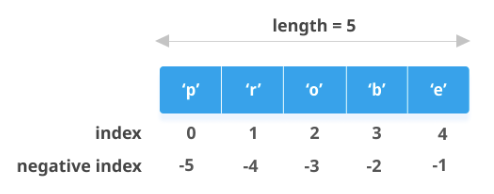Python list(列表),是Python中最常用的一种数据结构,它是一组用方括号括起来、逗号分隔的数据。
列表的元素可以是任何类型的,但使用时通常各个元素的类型是相同的。
列表支持加入不同数据类型的元素:数字、字符串、列表、元组等。
列表是可变的,因此即使在创建后也可以对其进行更改。
Python中的列表是有序的,并且有一定数量。 根据确定的序列对列表中的元素进行索引,并使用0作为第一个索引来完成列表的索引。
一、创建列表Creating a List
list1 = ['Google', 'Runoob', 1997, 2000]
list2 = [1, 2, 3, 4, 5 ]
my_list = ['p','r','o','b','e']
kong = [] #创建空白list,用于后面调用二、访问列表中的元素Accessing elements from the List
我们可以使用索引运算符[]访问列表中的项。索引必须为整数。嵌套列表通过嵌套索引访问。
索引的排序规则如下图,从零开始。

List = ["Geeks", "For", "Geeks"]
print(List[0]) 在使用索引访问列表中的元素时,使用的索引(下标)不可越界,否则会报如下错误
IndexError: list index out of range
以下几种情况会引起越界:
- 创建空的list,但使用list[0] 来访问其中元素
- 访问list[n] ,但是N大于len(list)
- 创建空的list,通过list[0]来赋值
三、添加或删除元素Adding or Removing Elements
我们可以使用内置的append()函数将元素添加到列表中。
通过使用append()方法,一次只能将一个元素添加到列表中,如果使用append()方法添加多个元素,则需要使用循环。
List = []
print(List)
# Addition of Elements
List.append(1)
List.append(2)
print(List)
# Adding elements to the List using Iterator
for i in range(1, 4):
List.append(i)
print(List) 其运行结果如下
[]
[1, 2]
[1, 2, 1, 2, 3]append()方法仅适用于List末尾的元素添加,如果需要在中间位置插入元素,则使用insert()方法。
insert()方法需要两个参数,位置和值。 insert(position, value)
List = [1,2,3,4]
print(List)
List.insert(3, 12)
List.insert(0, 'Geeks')
print(List)其运行结果如下
[1, 2, 3, 4]
['Geeks', 1, 2, 3, 12, 4]除了append()和insert()方法外,还有一个元素添加方法extend(),该方法用于在列表末尾同时添加多个元素。
我们可以使用内置的remove()函数从列表中删除元素,但是如果元素不存在于集合中,则会发生错误。
Remove()方法一次只删除一个元素,如需删除多个需要使用循环语句。
注意:remove(value)方法的参数是值,不是索引(index,下标),此方法将仅删除搜索到的元素的第一个匹配项。
List = [1, 2, 3, 4, 5, 6, 7, 8, 9, 10]
print(List)
List.remove(5)
List.remove(6)
print(List)运行结果如下
List = [1, 2, 3, 4, 5, 6, 7, 8, 9, 10]
print(List)
List.remove(5)
List.remove(6)
print(List)四、列表合并Merge lists
前面我们说过,使用append()方法,可以在列表尾部添加一个新元素,所以对于两个或者多个列表的合并不是很适用。
list1 = ['Google', 'Runoob', 1997, 2000]
list2 = [1, 2, 3, 4, 5 ]
list3 = [{'name': 'Soe', 'Sex': 'Female'}, {'name': 'John', 'Sex': 'Male'}]
newlist = list1.append(list2)
print(newlist)大家猜猜返回什么结果?
None。可见list的许多方法,都是应用在list本身的,不能赋值到新的list,这一点要注意。
list1.append(list2)
# Result: ['Google', 'Runoob', 1997, 2000, [1, 2, 3, 4, 5]]
list1.extend(list2)
# Result: ['Google', 'Runoob', 1997, 2000, 1, 2, 3, 4, 5]上面这些只能合并两个list,也不方便,下面才是真正常用的方法
newlist = list1 + list2 + list3
print(newlist)
# Result: ['Google', 'Runoob', 1997, 2000, 1, 2, 3, 4, 5, 1, 2, 3, 4, 5, {'name': 'Soe', 'Sex': 'Female'}, {'name': 'John', 'Sex': 'Male'}]
newlist = [*list1, *list2, *list3]
print(newlist)
# Result: ['Google', 'Runoob', 1997, 2000, 1, 2, 3, 4, 5, 1, 2, 3, 4, 5, {'name': 'Soe', 'Sex': 'Female'}, {'name': 'John', 'Sex': 'Male'}]
五、列表List的遍历以及判断元素是否在列表List中
通过for循环可以实现列表List的遍历
a = ['a', 'b', 'c', 'd', 'e']
# simple iterate 简单遍历
for i in a:
print(i)
# iterate with index 带索引的遍历
for i, el in enumerate(a):
print(i, el)
# iterate with custom index 自定义索引号吗的遍历
for i, el in enumerate(a, 1):
print(i, el)通过in方法可以判断元素是否在列表中
list1 = ['Google', 'Runoob', 1997, 2000]
if 'Google' in list1:
print(True)
# Result: True六、列表排序和去重去空Sort ,Remove duplicates, Remove NA
通过sort方法可以进行排序
list1 = ['Google', 'Yahoo', 'Baidu', 'Sogou']
list1.sort(reverse=True)
print(list1)
# Result: ['Yahoo', 'Sogou', 'Google', 'Baidu']sort函数还有一个告警用法sort(key=Function),我们在后续在探讨。
使用先set后list的方法可以实现对列表list元素进行去重
my_list = ['Google', 'Yahoo', 'Baidu', 'Sogou', 'Google']
newlist = list(set(my_list))
print(newlist)
# Result: ['Baidu', 'Yahoo', 'Google', 'Sogou']set()方法是创建一个集合,集合(set)是一个无序的不重复元素序列。创建完成集合set以后,在转换回来就还是一个列表list。
除了去重,还有经常遇到去除空值的情况
d = ['', '剧情', '喜剧', '恐怖', '', '伦理', '']
d_dropna = list(filter(None, d)) #去除列表空值
print(d_dropna)
# Result: ['剧情', '喜剧', '恐怖', '伦理']使用filter就可以过滤掉空值,然后在使用list将其格式转换为列表。
七、列表切片Slicing of a List
在Python列表中,有多种方法来打印包含所有元素的整个列表,但是要打印列表中特定范围的元素,我们使用切片操作。
注意:除了列表List,元组Tuple,字符串string 也可以进行切片操作。
切片操作的格式如下
list[start_index: end_index: step]start:表示是第一个元素对象,正索引位置默认为0;负索引位置默认为 -序列长度
end:表示是最后一个元素对象,正索引位置默认为 (序列长度-1);负索引位置默认为 -1
step:步长,end-start,步长为正时,从左向右取值。步长为负时,反向取值,默认为1,步长值不能为0
List = [1, 2, 3, 4, 5, 6, 7, 8, 9, 10]
print(List[0:])
print(List[:])
print(List[2:])
print(List[2:4])
print(List[2:100])
print('============================')
print(List[:-1])
print(List[::-1])
print(List[::-2])这里的[start_index:end_index] 是一个前开后闭的区间取值,例如[2:4]实际数学表示是[2:4),也就是获取第3个和第4个值。
运行结果如下
[1, 2, 3, 4, 5, 6, 7, 8, 9, 10]
[1, 2, 3, 4, 5, 6, 7, 8, 9, 10]
[3, 4, 5, 6, 7, 8, 9, 10]
[3, 4]
[3, 4, 5, 6, 7, 8, 9, 10]
============================
[1, 2, 3, 4, 5, 6, 7, 8, 9]
[10, 9, 8, 7, 6, 5, 4, 3, 2, 1]
[10, 8, 6, 4, 2]注意:切片操作不会出现索引(下标)越界的情况,Python内部有处理机制自动转换了,这里和通过索引访问列表list是不一样的。
八、列表的常用方法总结
用append()方法,在列表尾部添加单个新元素。
用insert()方法,在列表中指定位置添加元素。
用 “+” 运算符,将两个列表拼接出一个新列表。
用extend()方法,在一个列表后面拼接进另一个列表。
用del list[m] 语句,删除指定索引m处的元素。
用remove()方法,删除指定值的元素(第一个匹配项)。
用pop()方法,取出并删除列表末尾的单个元素。
用pop(m)方法,取出并删除索引值为m的元素。
用clear()方法,清空列表的元素。(杯子还在,水倒空了)
用del list 语句,销毁整个列表。(杯子和水都没有了)
用len()方法,统计全部元素的个数。
用count()方法,统计指定值的元素的个数。
用max()方法,统计元素中的最大值(要求元素类型相同;数字类型直接比较,其它类型比较id)
用min()方法,统计元素中的最小值(要求元素类型相同;数字类型直接比较,其它类型比较id)
用index()方法,查找指定值的元素的索引位置(第一个匹配项)。
用reverse()方法,翻转列表中的元素。
用copy()方法,浅拷贝并生成新的列表。
用deepcopy()方法,深拷贝并生成新的列表。
用sort()方法,在原列表基础上进行排序。
用sorted()方法,将新列表基础上对原列表的元素进行排序。
九、扩展习题
切片操作()
#判断回文
s = 'abba'
if s == s[::-1]:
print("True")
else:
print("False")
#数字翻转
#对于一个整数X,定义操作rev(X)为将X按数位翻转过来,并且去除掉前导0
def rev(x):
x = str(x)
return int(x[::-1])
z = 10590
print(rev(z))来点难度,leetcode题目,
Given an array of size n, find the majority element. The majority element is the element that appears more than ⌊ n/2 ⌋ times.
You may assume that the array is non-empty and the majority element always exist in the array.
Example 1:
Input: [3,2,3]
Output: 3
Example 2:
Input: [2,2,1,1,1,2,2]
Output: 2最好理解的解法
class Solution:
def majorityElement(self, nums):
majority_count = len(nums)//2
for num in nums:
count = sum(1 for elem in nums if elem == num)
if count > majority_count:
return num
#遍历数组,某元素出现次数大于半数,就返回该元素
#注意这里用到了生成器(1 for elem in nums if elem == num)最快的解法
class Solution:
def majorityElement(self, nums):
nums.sort()
return nums[len(nums)//2]
#众数必然出现在中间位置常见的错误
- TypeError: 'list' object is not callable
命名错误,使用了保留字list定义了变量
list = [1, 2, 3] #list是保留字,不能做变量
my_list = ['Google', 'Yahoo', 'Baidu', 'Sogou', 'Google']
newlist = list(set(my_list))
print(newlist)参考资料
https://mp.weixin.qq.com/s/OKf7N3xxrS0tJ_K8Srw-jA
https://www.geeksforgeeks.org/python-list/
https://www.yuanrenxue.com/python/python-list.html
转载请注明:IPCPU-网络之路 » Python的list列表详解